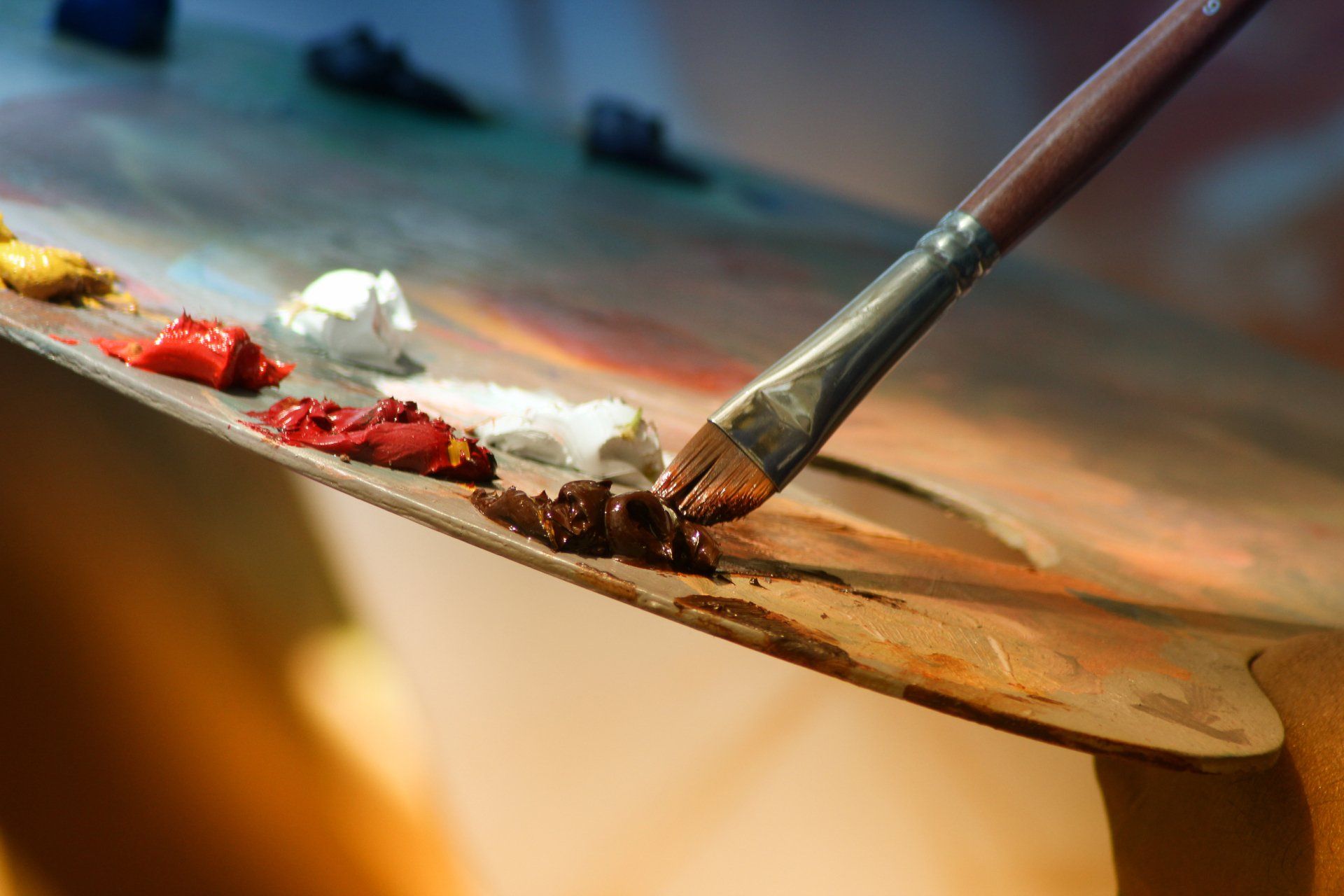Call Liz: 817-716-2114
Abstract Expressionism: The Unbridled Freedom of Artistic Expression

Abstract Expressionism: The Unbridled Freedom of Artistic Expression
In the aftermath of World War II, as cities in Europe and Asia lay in ruins, America emerged as a beacon of prosperity with its infrastructure and industry intact. This transformative period birthed the first homegrown art movement in the United States—Abstract Expressionism. This blog delves into the history, characteristics, and enduring impact of Abstract Expressionism, exploring the works of iconic artists like Jackson Pollock, Mark Rothko, and Willem de Kooning. We'll unravel the essence of this revolutionary movement and its unique place in the expansive tapestry of the art world.
The Historical Context: From Ruins to Revolution
As the Second World War came to a close, the world faced the colossal task of rebuilding shattered cities and reimagining the future. In contrast to the devastation witnessed in Europe and Asia, America's infrastructure and industry not only survived but thrived. This post-war prosperity provided a fertile ground for the emergence of a distinctly American art movement—Abstract Expressionism.
1. The Birth of a Movement:
Abstract Expressionism, often referred to as the first truly American art movement, took root in the 1940s and blossomed throughout the 1950s. It marked a departure from traditional European styles and embraced a radical form of abstraction that was uniquely American in its essence.
2. Prosperity and Cultural Shifts:
The economic prosperity of post-war America was coupled with profound cultural shifts. The nation, now a global power, sought to redefine its identity. Abstract Expressionism became a manifestation of this newfound confidence and a visual representation of the nation's evolving narrative.
Defining Abstract Expressionism: Brushstrokes, Spontaneity, and Gestures
Abstract Expressionism defies easy categorization, encompassing a diverse range of styles and approaches. At its core, it is characterized by gestural brushstrokes, mark-making, and an impression of spontaneity. The movement transcends the constraints of representation, inviting viewers to engage with the visceral and emotive qualities of the art.
1. Gestural Brushstrokes:
A defining feature of Abstract Expressionism is the use of gestural brushstrokes. Artists like Jackson Pollock became known for their dynamic and energetic application of paint, often employing unconventional methods such as dripping or pouring paint directly onto the canvas. This gestural approach embodied a sense of immediacy and direct expression.
2. Mark-Making and Texture:
Abstract Expressionist works are often characterized by the artist's distinctive mark-making. These marks, whether bold strokes, intricate lines, or subtle textures, contribute to the overall composition. Texture becomes a language through which the artist communicates emotions and thoughts.
3. Impression of Spontaneity:
The impression of spontaneity is a hallmark of Abstract Expressionism. The movement embraced a freedom of expression that allowed artists to tap into their subconscious and create in the moment. This spontaneity liberated art from the constraints of representation, opening up new realms of possibility.
The Pioneers: Jackson Pollock, Mark Rothko, and Willem de Kooning
To understand Abstract Expressionism, one must delve into the groundbreaking works of its pioneers—artists whose contributions shaped the movement and left an indelible mark on the trajectory of modern art.
1. Jackson Pollock: The Drip Painter:
Jackson Pollock, often hailed as the epitome of Abstract Expressionism, redefined the act of painting with his revolutionary drip technique. His famous "drip paintings," created by allowing paint to drip or be poured onto a canvas laid on the ground, represented a radical departure from traditional methods. "Autumn Rhythm" and "Number 1A, 1948" stand as iconic examples of Pollock's groundbreaking approach.
2. Mark Rothko: The Master of Color Fields:
Mark Rothko's contribution to Abstract Expressionism lies in his mastery of color fields. His paintings, characterized by large, luminous blocks of color, evoke profound emotional responses. Works like "No. 5/No. 22" and "Orange and Yellow" are immersive experiences that transcend the boundaries of representation, inviting viewers to immerse themselves in the hues and emotions of Rothko's creation.
3. Willem de Kooning: The Figurative Abstractionist:
Willem de Kooning, known for his figurative abstraction, brought a dynamic and expressive quality to Abstract Expressionism. His "Woman" series, including "Woman I" and "Woman III," reflects a bold and confrontational approach to the female form. De Kooning's ability to merge abstraction with figuration added a layer of complexity to the movement.
Personal Reflections: The Unique Language of Abstract Expressionism
As an artist drawn to Abstract Expressionism, the allure lies in the freedom to express oneself without the constraints of representation. The uniqueness of this style lies not only in its visual impact but in the profound and personal connection it fosters between the artist and the observer.
1. Freedom of Expression:
Abstract Expressionism offers artists the freedom to explore the depths of their psyche and express the ineffable. The absence of recognizable forms liberates the artist from the need to convey a specific subject, allowing for a direct and unfiltered connection with the canvas.
2. Unique Perspectives:
The beauty of Abstract Expressionism lies in its openness to interpretation. Each viewer brings their own experiences, emotions, and perspectives to the artwork, creating a rich tapestry of meanings. This open-ended quality allows for a continuous dialogue between the art and its audience.
3. Emotional Resonance:
The emotive power of Abstract Expressionism is profound. The raw and unbridled expression of emotion, whether joy, anguish, or contemplation, resonates with those who engage with the art. The viewer is invited into a visceral experience that transcends the need for a concrete narrative.
Abstract Expressionism in the Art World: A Paradigm Shift
The impact of Abstract Expressionism on the art world was revolutionary, heralding a paradigm shift that redefined the boundaries of artistic expression and representation.
1. Breaking with Tradition:
Abstract Expressionism marked a decisive break from traditional artistic norms. The movement rejected the idea that art must adhere to recognizable forms and sought to convey meaning through the act of creation itself. This departure from representational art opened new avenues for experimentation.
2. Global Influence:
The influence of Abstract Expressionism extended far beyond the borders of the United States. The movement had a profound impact on the global art scene, inspiring artists in Europe, Asia, and beyond to explore new forms of expression. The universal language of abstraction became a powerful force in the dialogue of contemporary art.
3. Shaping Subsequent Movements:
Abstract Expressionism served as a catalyst for subsequent art movements, influencing the trajectory of modern and contemporary art. The emphasis on individual expression, gestural abstraction, and the liberation of form resonated with artists in movements such as Color Field Painting, Action Painting, and Lyrical Abstraction.
The Enduring Legacy: Abstract Expressionism Today
The legacy of Abstract Expressionism persists in the contemporary art landscape, with artists drawing inspiration from its principles and pushing the boundaries of abstraction.
1. Contemporary Abstractionists:
Artists today continue to explore abstraction as a means of expressing
complex emotions and ideas. The legacy of Abstract Expressionism is evident in the works of contemporary abstractionists who embrace the freedom to create beyond the confines of representation.
2. Digital Expressionism:
The digital age has given rise to new forms of expression that echo the principles of Abstract Expressionism. Digital artists leverage technology to create dynamic, gestural works that capture the spontaneity and energy of the movement. The digital realm becomes a canvas for the continuation of Abstract Expressionist ideals.
3. Influence on Other Disciplines:
The influence of Abstract Expressionism extends beyond the realm of visual art. Its principles have inspired musicians, dancers, writers, and filmmakers. The ethos of individual expression and the emotive power of abstraction resonate across diverse creative disciplines.
Conclusion: The Unbounded Spirit of Expression
Abstract Expressionism stands as a testament to the unbounded spirit of artistic expression. In a world emerging from the ravages of war, this movement blossomed as a beacon of freedom, transcending the constraints of representation and inviting artists and viewers into a realm of pure emotion and spontaneity.
As we reflect on the contributions of Abstract Expressionism to the art world, we recognize its transformative impact and enduring relevance. The movement's ability to capture the essence of a moment, to communicate the inexpressible, and to transcend the boundaries of conventional artistic norms cements its place as a cornerstone in the evolving narrative of human creativity. In the unbridled strokes and vibrant hues of Abstract Expressionism, we find not just a moment in history but a timeless celebration of the unbounded spirit of artistic expression.

All Rights Reserved | Liz Johnston Art


